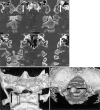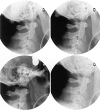Atlanto-occipital dislocation: four case reports of survival in adults and review of the literature
- PMID: 14673716
- PMCID: PMC3476575
- DOI: 10.1007/s00586-003-0653-5
Atlanto-occipital dislocation: four case reports of survival in adults and review of the literature
Abstract
Traumatic atlanto-occipital dislocation (AOD) is a rare cervical spine injury and in most cases fatal. Consequently, relatively few case reports of adult patients surviving this injury appeared in the literature. We retrospectively report four patients who survived AOD injury and were treated at our institution. A young man fell from height and a woman was injured in a traffic accident. Both patients survived the injury but died later in the hospital. The third patient had a motorcycle accident and survived with incomplete paraplegia. The last patient, a man involved in a working accident, survived without neurological deficit of the upper extremities. Rigid posterior fixation and complete reduction of the dislocation were applied in last two cases using Cervifix together with a cancellous bone grafting. Previously reported cases of patients surviving AOD are reviewed, and clinical features and operative stabilisation procedures are discussed.
Figures







References
Publication types
MeSH terms
LinkOut - more resources
Full Text Sources
Medical

